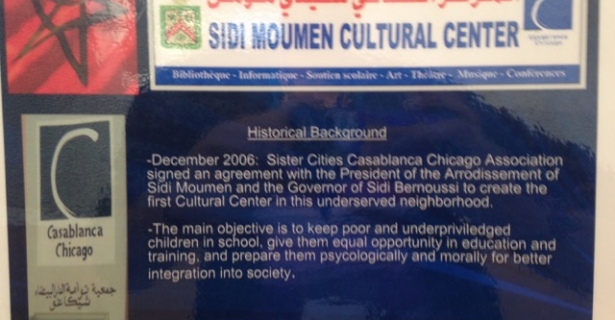In Marrakesh, we visited the Ben Youssef Medersa, the oldest Islamic college in North Africa and largest in Morocco, a mere ten-minute walk from where we were staying. The college was built during the reign of Sultan Ali Ibn Yusuf, whose reign was from 1106 to 1142. The mosque was reconstructed and ultimately completed in the sixteenth century.
Interestingly, the informational signage inside the madrasa as well as the Museum of Marrakesh (which was adjacent to the mosque and which we visited right afterward) was solely in French and Arabic. It seemed that the many tourists who were not fluent in either hired private tour guides to explain additional background and context. The center of the madrasa revealed this stunning courtyard, characterized by the same intricate design pictured above. The symmetry and rectilinear style is an archetype of Islamic architecture, as is the space for the reflecting pool in the center. The serenity of this space contrasted quite starkly with the business of Medina, the surrounding area characterized by bustling stalls, motorbikes, and crowded streets.
The role of madrasas in Morocco has shifted over time. At their inception, madrasas in Morocco often had curriculums lasting for over ten years, which included both secular and religious subjects. During European colonization, much of the influence of Islam was removed from the curricula, which grew more Westernized. As a result, the prevalence of madrasas diminished, especially in cases where there was inadequate state support to sustain them.
Especially after the 2003 Casablanca bombings, Moroccan education and its approach to religion in general has changed drastically. The monarchy, in conjunction with local councils and ministries, has made a concerted effort to revamp Morocco’s educational system and propagate the message that Islam is a cohesive, state-building ideology rather than a religion justifying violence and the tactics used by ISIL and Al Qaeda.
The presence of heritage sites such as Medersa Ben Youssef alongside madrasas that are operating in the present-day indicates the importance of education in the history and current development of the country. However, these repercussions are not limited to Morocco. Various other nations, including Russia and Senegal, are sending imams and other religious representatives to Morocco to study. The kingdom pays for many international students to attend its domestic institutions, and this is worth the drain in resources because it reaffirms the notion that King Mohammed VI is the supreme religious authority, indicating that he holds sway internationally as well as within Morocco. The infusion of political authority with religious institutionalization and emphasis on moderate interpretations of Islam is thus useful for both Morocco and Western nations engaged in counterterrorism efforts.
Walking around the mosque, we observed a great number of very small dormitory rooms (all of which were open to visitors) with windows looking over the courtyard as pictured to the left. The entire madrasa housed roughly 900 students. Classes were held here until 1960, and a couple decades later the mosque reopened to the public as a cultural heritage site. Each room seemed very cramped, and just fit the five of us comfortably. There was mainly just the one window, and sometimes a hatch overhead.
While visiting this site without understanding the current context of religious education may make it seem as though madrasas are a thing of the past, the key aspect of this experience reaffirmed the idea that they hugely influence religion and education today, both in Morocco and worldwide. At the heart of counterterrorism efforts, there must be a deep understanding of soft power tactics in addition to hard power measures. Countries like Saudi Arabia are largely responsible for funding Wahhabist and Salafist madrasas worldwide that often contribute to the root cause of radicalization. Understanding how to reform education and fight that type of ideology is a key aspect in limiting the spread of extremist violence, and Morocco is positioning itself as a leader in that effort. Throughout our stay here so far, a number of people have asked us where we are from, immediately following it up with the message that Morocco is a peaceful country, and that Islam is a nonviolent religion. Both the king and the people clearly prioritize this characterization, and are taking steps both in talking to tourists and revamping their education policies to make reforms occur at the personal level.


Add new comment